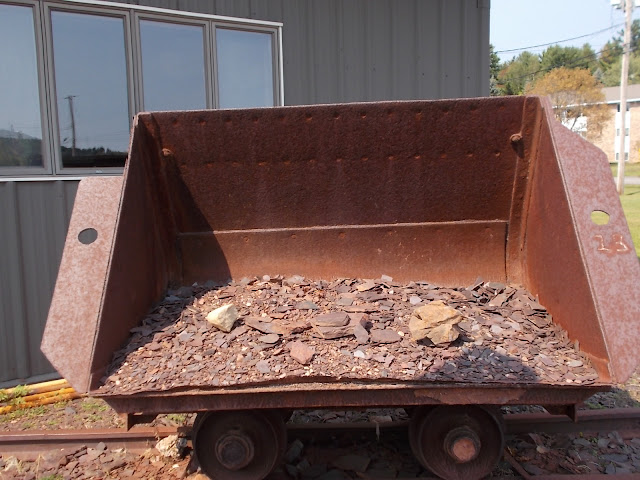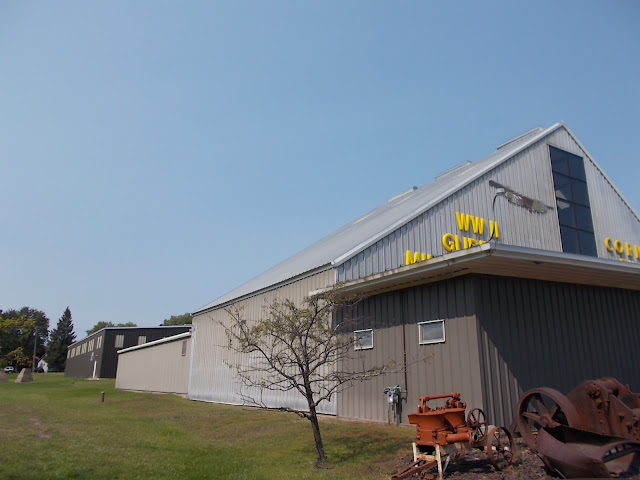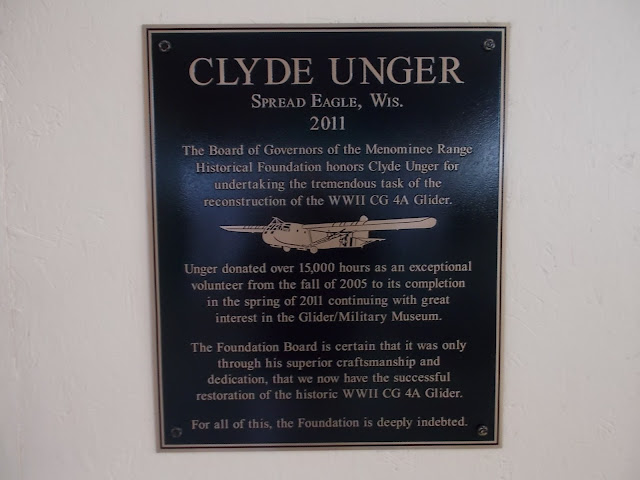The very name of this city, Iron Mountain, reveals one of its most important assets, the mining of iron ore. The below link will show some basic information about Iron Mountain.
https://en.wikipedia.org/wiki/Iron_Mountain,_Michigan
In the above Iron Mountain link, you will also note reference to the Millie Mine / Hill Bat Cave viewing site that I showed in my last Post.
The time has come to view the WWII Glider Museum.
The WW Glider & Military Museum here in Iron Mountain, Michigan, is actually a joint attraction with The Cornish Pumping Engine and Mining Museum.
We did not visit the Cornish Pump and Mining Museum. But because it is housed in the same museum complex with the WWII Glider Museum, I wanted to, at the very least, acknowledge it. You can also read about this massive pump in the above Iron Mountain link.
In each of the next two photos, notice the green and white sign.
In the below photo, is a close up of the green and white sign.
As I said above, we did not visit the Cornish Pump and Mining Museum. The pump museum is housed in the building you see above and below.
The below photos show some of the equipment used to mine the iron ore.
Below are two close up photos of the iron ore in the above left mining car.
From this collection of rocks, iron is produced. Amazing!
Now I will show the WWII Glider Museum.
In the right foreground of the below photo, you can see the side of the building that you saw in several frontal photos above. This building houses the Cornish Pump and Mining Museum.
Also, in the below photo, notice that there is another, dark gray, building to its rear.
The dark gray building (above and below) houses the WWII Glider and Military Museum.
As you enter the building, the below honorary plaque is on display.
Clyde Unger. Without whom the Waco CG 4A glider you will see below may not have been restored.
Several general, non-glider, displays in the museum.
The WACO CG 4A Glider.
https://en.wikipedia.org/wiki/Waco_CG-4
The Kingsford, Michigan, plant mentioned in the above informational link, is immediately connected to and adjacent to Iron Mountain.
A model of the glider gives visitors a good overview of what it looks like.
The Waco CG 4A Glider.
I was amazed that, in addition to the pilot and copilot, one of the Waco CG 4A Gliders could only hold 13 combat troops.
I had read about the use of gliders in various historical journals of WWII battles, especially in the European Theater of Operations.
I really enjoyed visiting the museum.
Smiles,
Cap and Patti who waited outside, comfortably in our truck.
In the above Iron Mountain link, you will also note reference to the Millie Mine / Hill Bat Cave viewing site that I showed in my last Post.
The time has come to view the WWII Glider Museum.
The WW Glider & Military Museum here in Iron Mountain, Michigan, is actually a joint attraction with The Cornish Pumping Engine and Mining Museum.
We did not visit the Cornish Pump and Mining Museum. But because it is housed in the same museum complex with the WWII Glider Museum, I wanted to, at the very least, acknowledge it. You can also read about this massive pump in the above Iron Mountain link.
In each of the next two photos, notice the green and white sign.
In the below photo, is a close up of the green and white sign.
As I said above, we did not visit the Cornish Pump and Mining Museum. The pump museum is housed in the building you see above and below.
The below photos show some of the equipment used to mine the iron ore.
Below are two close up photos of the iron ore in the above left mining car.
From this collection of rocks, iron is produced. Amazing!
Now I will show the WWII Glider Museum.
In the right foreground of the below photo, you can see the side of the building that you saw in several frontal photos above. This building houses the Cornish Pump and Mining Museum.
Also, in the below photo, notice that there is another, dark gray, building to its rear.
The dark gray building (above and below) houses the WWII Glider and Military Museum.
As you enter the building, the below honorary plaque is on display.
Clyde Unger. Without whom the Waco CG 4A glider you will see below may not have been restored.
Several general, non-glider, displays in the museum.
The WACO CG 4A Glider.
https://en.wikipedia.org/wiki/Waco_CG-4
The Kingsford, Michigan, plant mentioned in the above informational link, is immediately connected to and adjacent to Iron Mountain.
A model of the glider gives visitors a good overview of what it looks like.
The Waco CG 4A Glider.
I was amazed that, in addition to the pilot and copilot, one of the Waco CG 4A Gliders could only hold 13 combat troops.
I had read about the use of gliders in various historical journals of WWII battles, especially in the European Theater of Operations.
I really enjoyed visiting the museum.
Smiles,
Cap and Patti who waited outside, comfortably in our truck.



































No comments:
Post a Comment
TO ENTER A COMMENT .. SELECT A PROFILE BY CLICKING ONTO THE 'SELECT A PROFILE' BUTTON ABOVE. THE MOST SIMPLE METHOD IS TO EITHER SELECT (BY CLICKING ONTO) A GOOGLE ACCOUNT (WHICH CAN SIMPLY BE A GOOGLE G-MAIL ADDRESS) OR TO SELECT ANONYMOUS. THEN WRITE YOUR COMMENT AND IF YOU WISH .. PREVIEW YOUR COMMENT .. AND THEN CLICK ONTO THE PUBLISH BUTTON TO PUBLISH IT ..
THANK YOU FOR YOUR INTEREST IN MY WEB SITE .. I REALLY APPRECIATE YOUR TAKING THE TIME AND GOING TO THE WORK TO POST A COMMENT HERE .. CAP